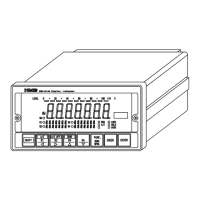30
(2)
When loading condition and output condition for load cell are clear.
(In case desired accuracy is more than 1/1 000 or so.)
Warning ● The accuracy obtained by the calibration of this procedure, consists
from combined accuracy with the instrument and combined strain
gage applied transducer, the accuracy of weight used in the
calibration, error factors on mechanical and also error factors on
calibration works, that is total accuracy. If high accuracy is required,
full consideration should be made on each factors. If neglected, there
may be a case that desired accuracy shall not be obtained.
When high accuracy is required, actual load calibration by the weight is needed.
For example, we’ll show the calibration procedures in the following condition, that is, 3 points
of load cells with 3 mV/V of rated output and 5 t of rated capacity.
Tare weight : 1.5 t
Weighing capacity : 5 t
Maximum display value : 5 000
1
Calculate the output of load cell at the maximum display from the above conditions.
(Output of load cell
at maximum display.
(Rated output)+(Rated output)+(Rated output)
Numbers of load cell
×
××
×
3 points ×
××
× 5 t
=
==
=
(Numbers of load cell)×
××
×(Rated capacity)
(Weighing capacity)
=
==
=
3 points
3 mV/V + 3 mV/V + 3mV/V
×
××
×
5 t
=
==
=
1 mV/V
2
Execute the calibration with the load cell section applied initial load(tare weight), according to
paragraph 5−2−1. In this case, make input to “5 000” in step 5, and “1.000 00” in step 7 each.
3
Apply fine adjustment according to the paragraph 5−2−2. At the same time, apply 5 t load as
for “the optional constant load”.

